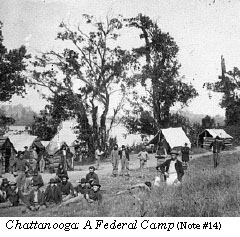

Sherman continued to win battles and throw fits, until, on May 7, 1864, he
began his infamous march in Chattanooga, Tennessee. The objective of the march
was to capture the South's manufacturing centers, railroad junctions, and the
very heart of the South, Atlanta. He marched along the crucial Western &
 Atlantic Railroad taking with him 100,000 experienced
soldiers.(12)
Opposing his effort, were 65,000 men under General Joseph E. Johnston.
Johnston had recently replaced General Bragg after the disasters at Lookout
Mountain and Missionary Ridge.
Atlantic Railroad taking with him 100,000 experienced
soldiers.(12)
Opposing his effort, were 65,000 men under General Joseph E. Johnston.
Johnston had recently replaced General Bragg after the disasters at Lookout
Mountain and Missionary Ridge.
The march to Atlanta took four months. Those four months were long for Johnston, who could do very little to push back Sherman, since they were traveling in undefended country. Johnston did the best he could using a hit-and-run strategy of fighting a little, falling back to a safe spot, and so forth, but always making sure he kept Atlanta protected.
During May and June, they fought eight times. At one of the battles, Kennesaw Mountain, Sherman made a bad judgment: his men attacked in a succession of frontal assaults. It proved costly; the Union lost 3,000 men to Johnston's 600.(15) Sherman had repeated the same mistake that Grant had done at Cold Harbor, Virginia a few weeks ago.
By mid-July, Sherman had pushed Johnston into the embankments of the city.
The President of the Confederacy, President Davis, was terribly upset that
Sherman was allowed to "get within sight of
Atlanta."(16)
Johnston was immediately fired and General John B. Hood put in his place
as the commander of the Army of Tennessee. General Hood had fought in
Gettysburg, where he lost an arm and at Chickamauga, a leg.